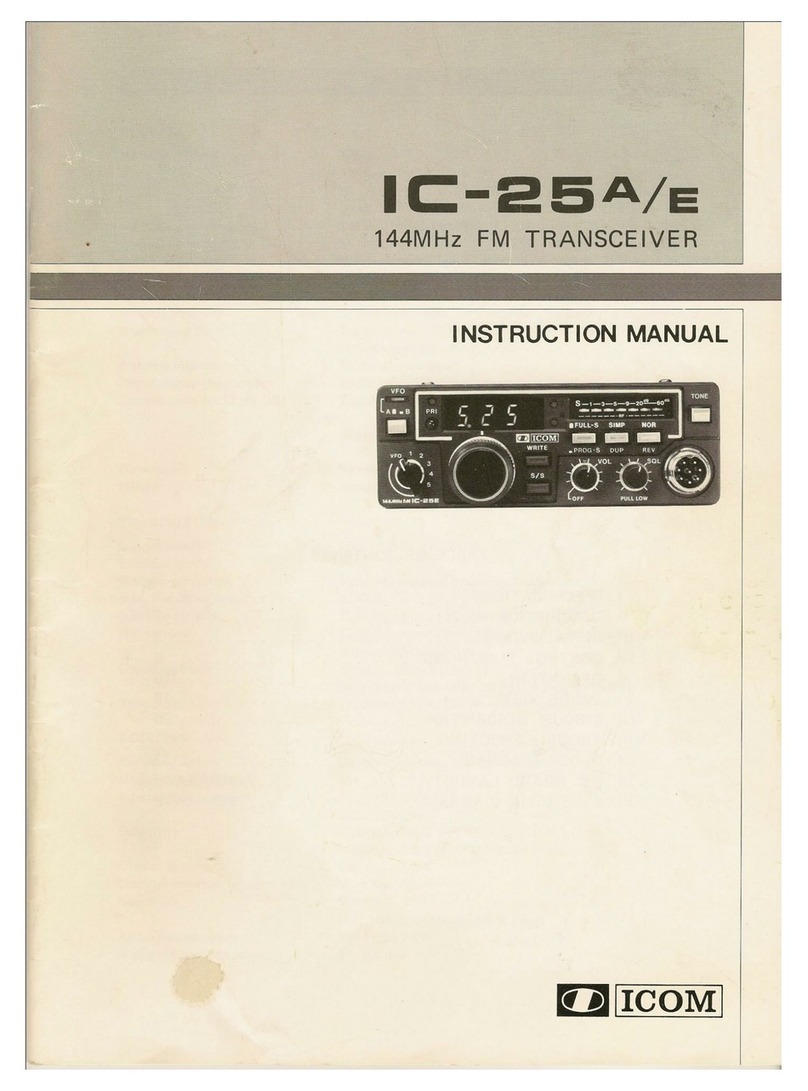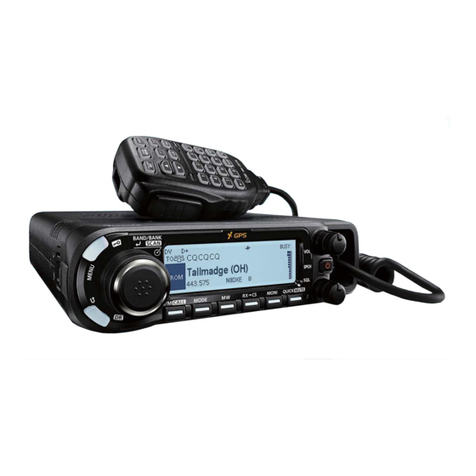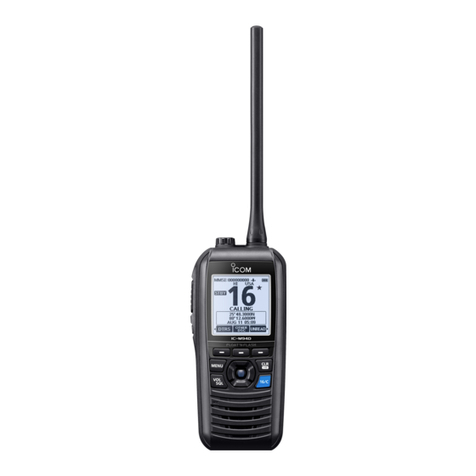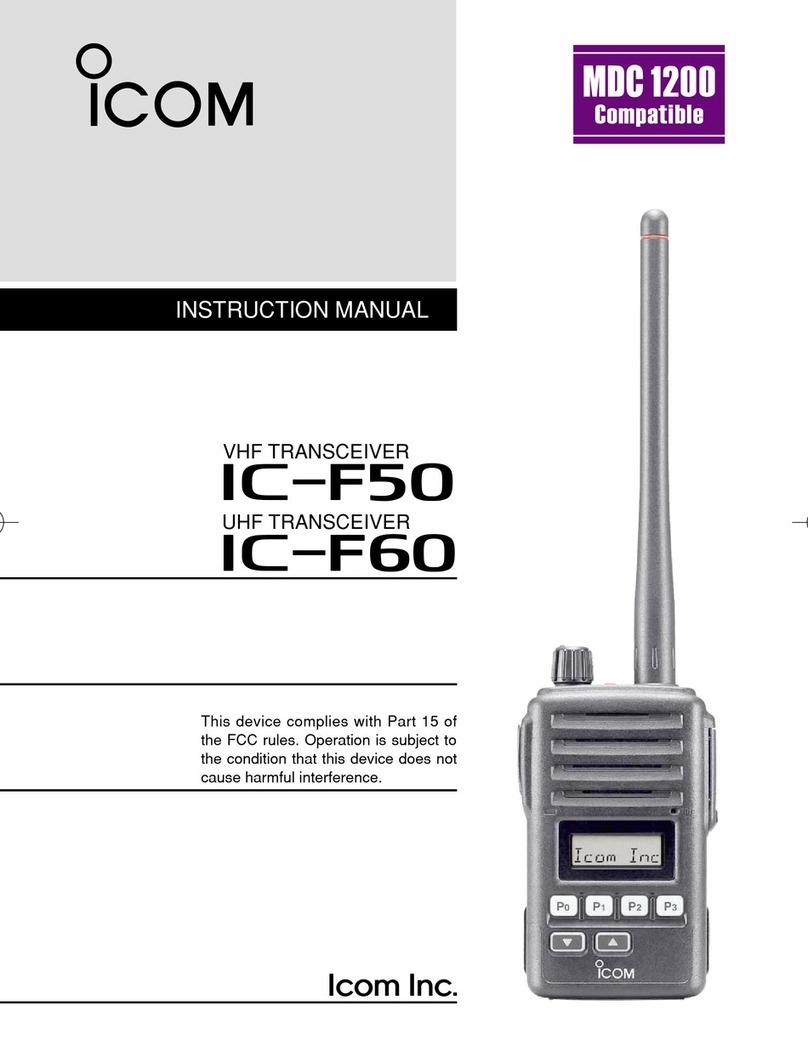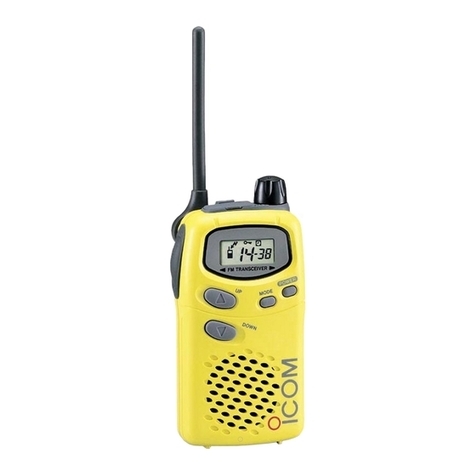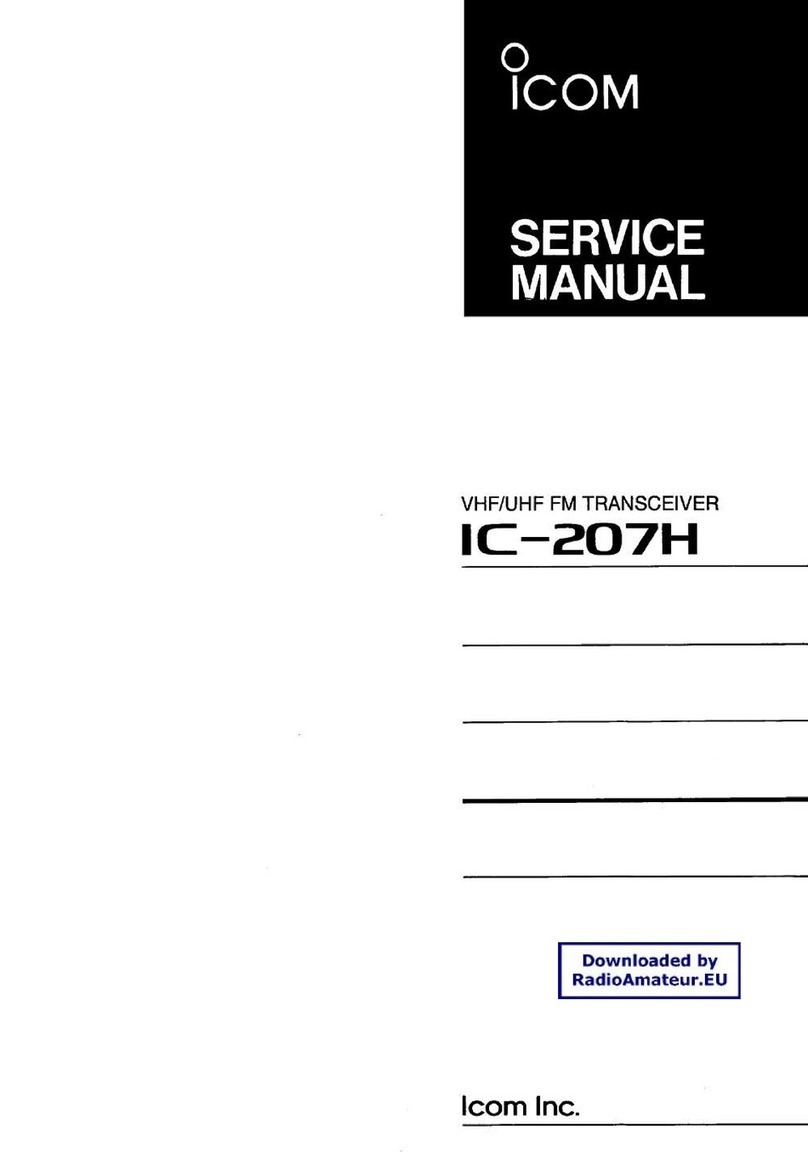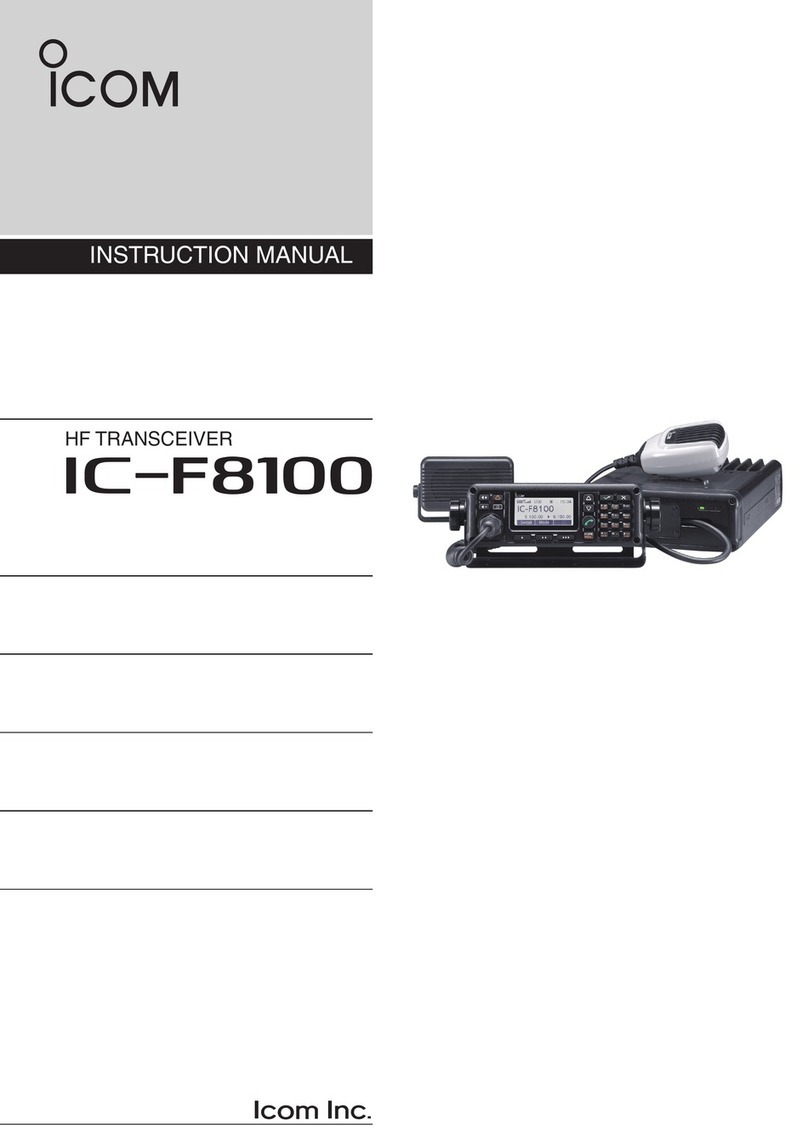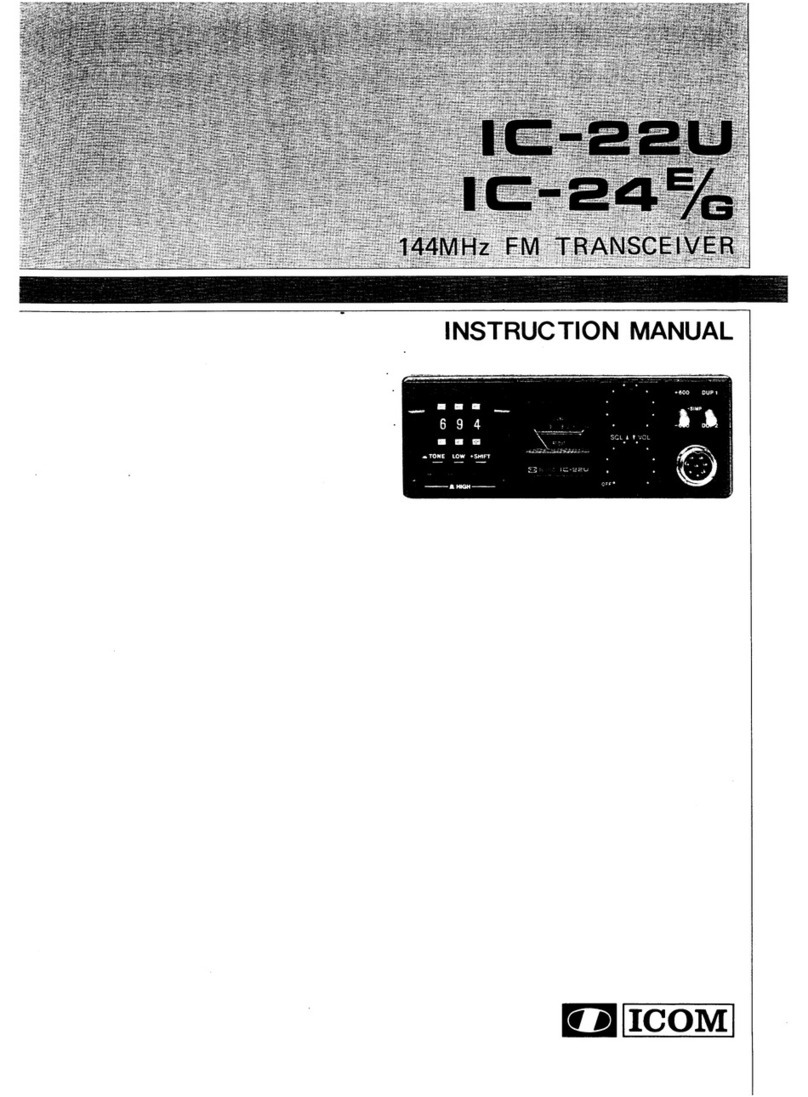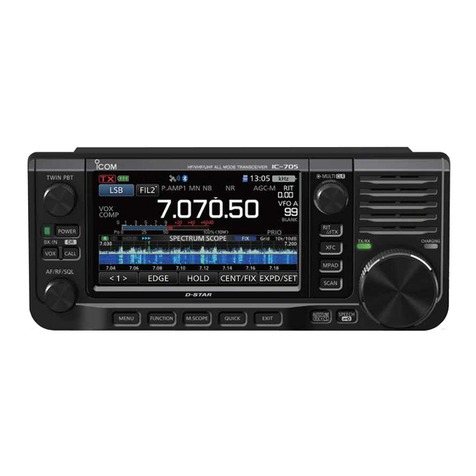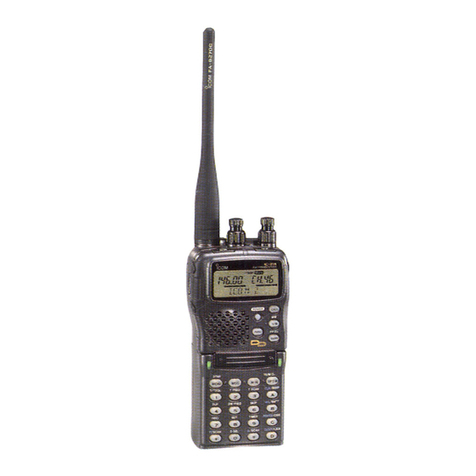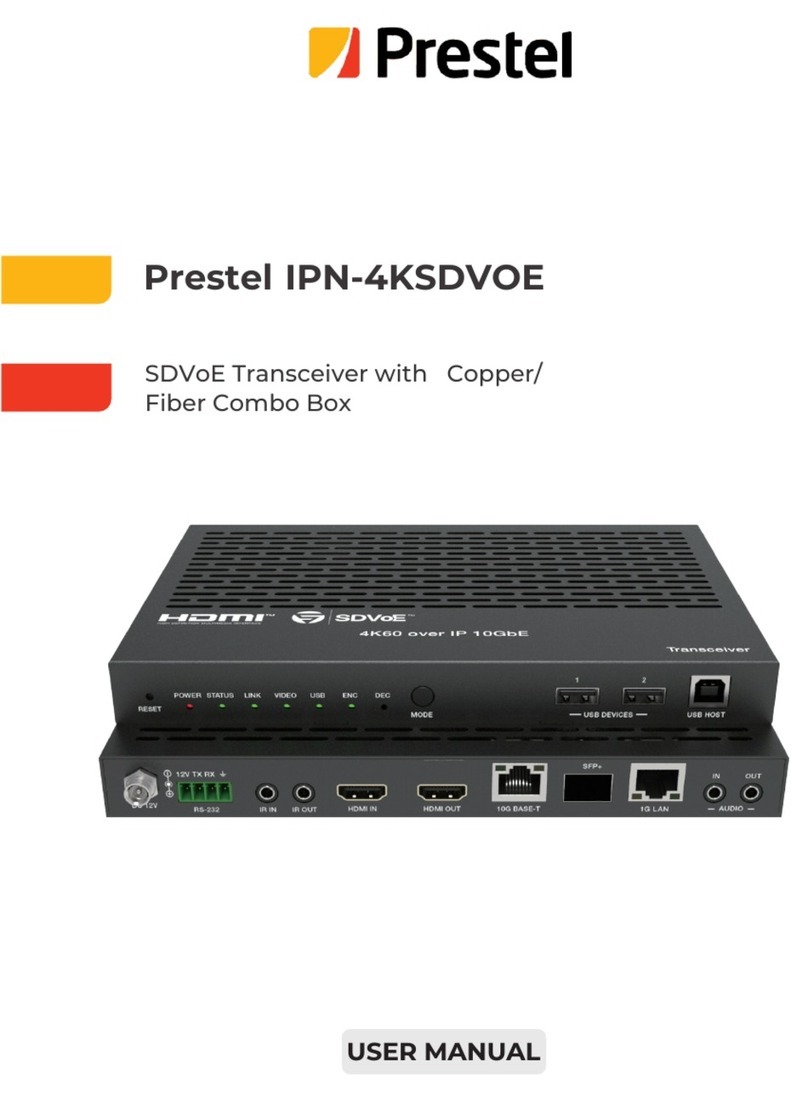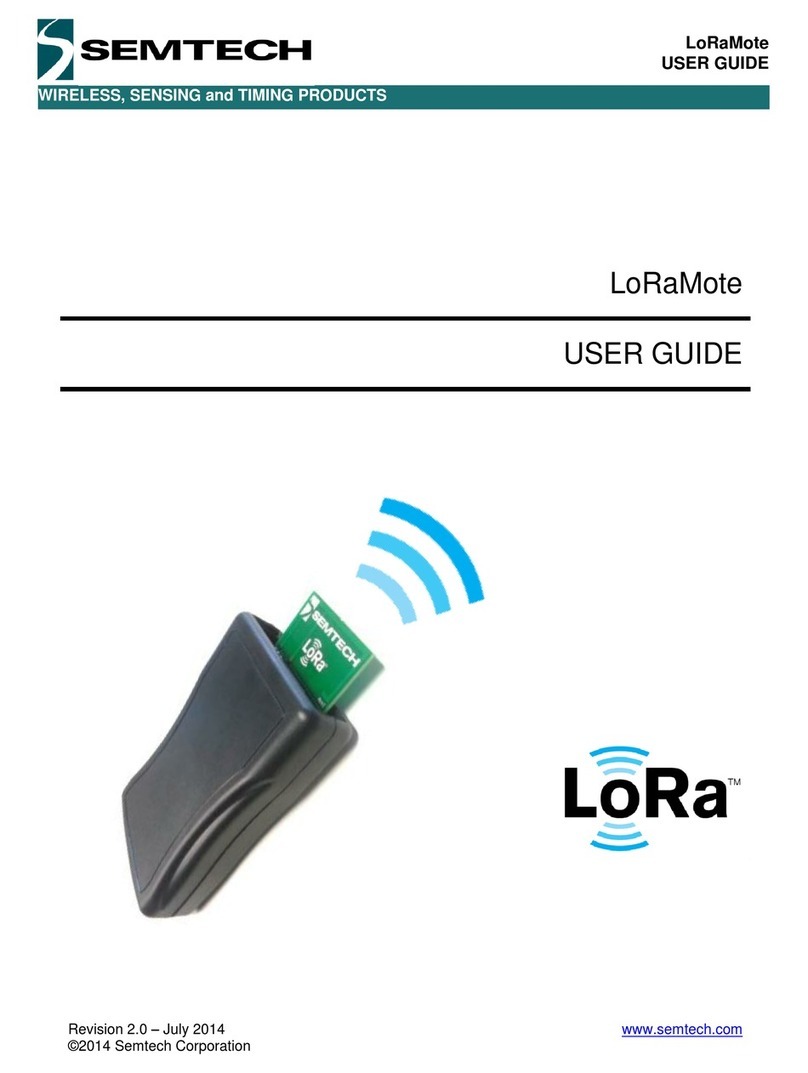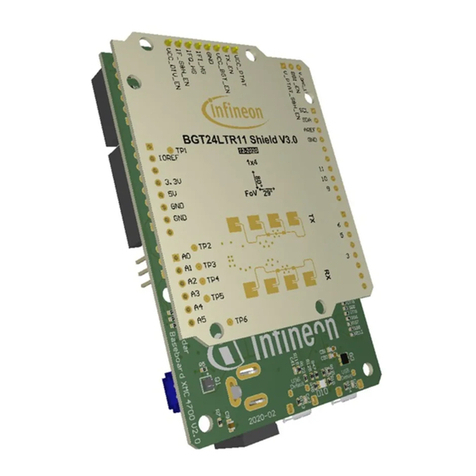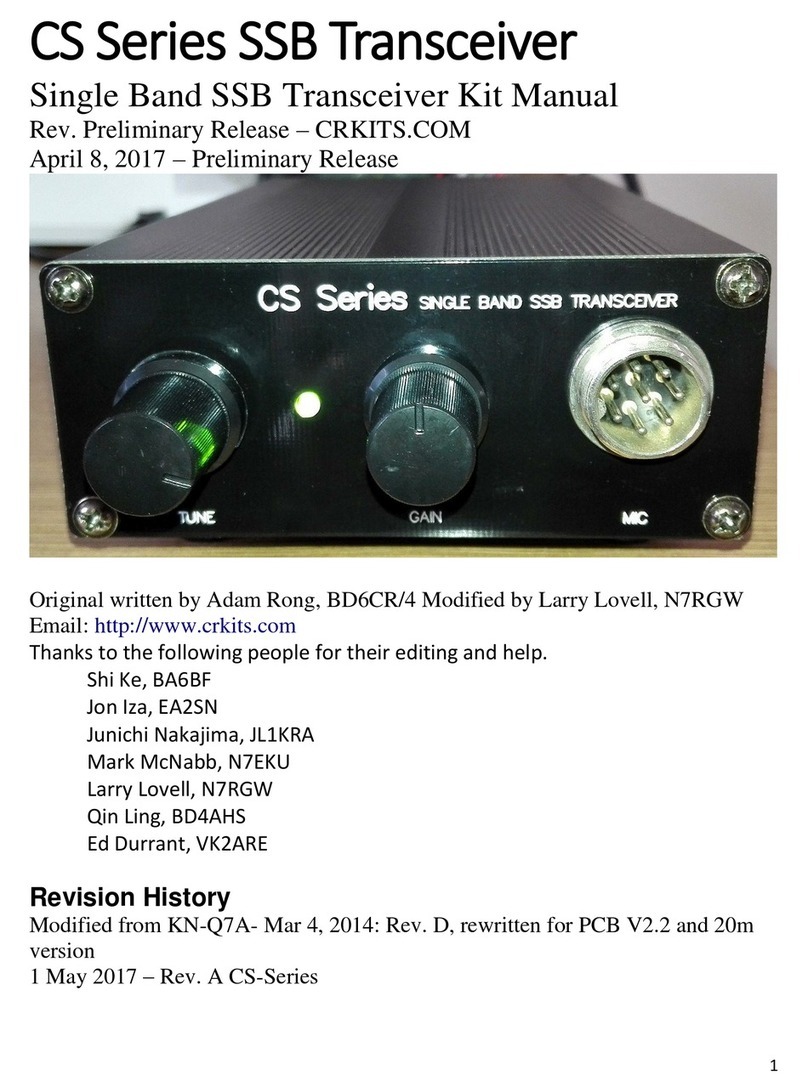Icom IC-F29DR User manual

OPERATING INSTRUCTIONS
Iç-F29DR
dPMR446/PMR446 TRANSCEIVER

i
INTRODUCTION
FOREWORD
Thank you for choosing this Icom transceiver.
IMPORTANT
FIRST, CAREFULLY READ THE INSTRUCTION MANUAL that is provided with the transceiver.
SAVE THESE OPERATING INSTRUCTIONS—
These operating instructions contain additional important
operating instructions for the IC-F29DR dPMR446/PMR446 TRANSCEIVER.
This transceiver includes some functions that are usable only when they are preset by your dealer. Ask your Icom
dealer or system operator for details.
Icom, Icom Inc. and the Icom logo are registered trademarks of
Icom Incorporated (Japan) in Japan, the United States, the United
Kingdom, Germany, France, Spain, Russia, Australia, New Zealand,
and/or other countries.
dPMR and the dPMR logo are trademarks of the dPMR MoU
Association.
All other products or brands are registered trademarks or
trademarks of their respective holders.
TABLE OF CONTENTS
FOREWORD .............................................................. i
IMPORTANT............................................................... i
1. ACCESSORIES .................................................... 1
Attaching or detaching accessories........................... 1
DBattery pack...........................................................1
DBelt clip ..................................................................1
DJack cover..............................................................2
2. PROGRAMMABLE KEY FUNCTIONS................. 3
Programmable key functions..................................... 3
3. LED INDICATOR................................................... 5
About the LED indicator............................................. 5
4. SETTINGS............................................................. 7
Setting the Beep function .......................................... 7
Setting the beep and announcement level ................ 8
Setting the Call-Ring ringer ....................................... 9
Setting the ringer level............................................. 10
Setting the microphone gain.....................................11
Setting the squelch level.......................................... 12
Setting the VOX function ......................................... 13
Setting the VOX gain............................................... 14
5. dPMR™ OPERATION......................................... 15
Receiving and transmitting ...................................... 15
DReceiving .............................................................15
DTransmitting .........................................................16
Break-in function...................................................... 17
DReceiving .............................................................17
DTransmitting .........................................................17
Status call................................................................ 18
DReceiving .............................................................18
6. OTHER FUNCTIONS.......................................... 19
Setting a scan type.................................................. 19
Tone Scan function .................................................. 20

Section 1
1
ACCESSORIES
Attaching or detaching accessories
DBattery pack
Attach or remove the battery pack, as illustrated to the
right.
To attach the battery pack:
1) Place the tabs on the bottom of the battery pack
into the slots at the bottom of the transceiver. (q)
2) Push the battery pack until the battery release
buttons make a ‘click’ sound. (w)
Battery release
b
uttons
q
w
r
ee
To attach To detach
To attach To detach
w
e
Ta b
q
DBelt clip
To attach the belt clip:
Slide the belt clip in the direction of the arrow until the
belt clip locks in place, and makes a ‘click’ sound. (q)
To detach the belt clip:
Lift the tab up (w), and slide the belt clip in the
direction of the arrow (e).
To detach the battery pack:
1) Push the battery release buttons in the direction of
the arrow as shown to the right. (e)
2) The battery pack is then released, and you can
remove it. (r)
NOTE:
Before attaching or detaching the belt clip, remove
the battery pack from the transceiver, if it is attached.

1
2
ACCESSORIES
DJack cover
To attach the jack cover:
1) Place the jack cover over the speaker-microphone
jack. (q)
2) Insert and tighten the screws. (w)
Attaching or detaching accessories (Continued)
e
er
w
w
q
To detach the jack cover:
1) Unscrew the screws using a Phillips screwdriver.
(e)
2) Detach the jack cover. (r)
CAUTION:
The transceiver meets IP67 requirements for dust-
tight and waterproof protection, only when the jack
cover or the optional HM-168LWP, HS-94LWP, or
HS-95LWP speaker microphone is attached.

3
Section 2PROGRAMMABLE KEY FUNCTIONS
Programmable key functions
You can assign the functions described below to [Top],
[Upper], and [Lower] by using the CS-F29DR cloning
software (purchase separately).
Ask your dealer for details.
Null
➥No function is assigned.
ZONE
➥Push to toggle the operating Zone.
•Eachtimetheuserpushesthiskey,thetransceiver
selects Zone 1, Zone 2, and then Zone 1 again.
SCAN
➥Push to start or pause a scan.
•WhenascanisstartedwiththePowerONScanorthe
Automatic scan function, push this key to pause the
scan. The paused scan resumes after a set time period.
➥Hold down this key while a scan is paused, and
then the channel is removed from the scan group.
•Theremovedchannelisautomaticallyaddedtothe
scan group again, after the scan is canceled.
MONI
➥While holding down this key, the C.Tone* mute
is released, even if the received signal does not
include a matching C.Tone*.
* CTCSS tone or DTCS code
LOCK
➥Hold down to turn the Key Lock function ON or
OFF.
•EvenwhentheKeyLockfunctionisON,[PTT],[MONI],
[LOCK], [CALL], [CLEAR], [SURVEILLANCE], and
[SIREN] are not locked.
CALL // only on a Digital channel //
➥Push to make a call that includes a Common ID.
CLEAR // only on a Digital channel //
➥Pushtonishacommunicationbysendingaclear
down signal. After the other station receives the
clear down signal, the transceiver automatically
enters to the Stand-by mode.
BREAK // only on a Digital channel //
➥Hold down to send a Break-in request call.
•TheBreak-inrequestcallannouncestotheother
stations on the channel that the user wants to break into
the current communication in the group. The transceiver
waits for the current communication to end. After the
communication ends, the transceiver automatically
sends the call.
➥While waiting, push this key to cancel the Break-in
request call.
S-RING/C-RING
// only on an Analog channel //
➥Push to make a Smart-Ring call.
// on both an Analog and a Digital channel //
➥Hold down to make a Call-Ring call.
NOTE: See the instruction manual that comes with
the transceiver for the default settings of these keys.
[Rotary Selector]
[VOL]
[Lower]
[Upper]
[PTT]
[Top]
NOTE:
Select the channels to be scanned by using
CS-F29DR cloning software.

4
PROGRAMMABLE KEY FUNCTIONS
2
Programmable key functions (Continued)
SURVEILLANCE
➥Hold down to turn ON the Surveillance function.
➥Push to turn OFF the function.
•WhenthisfunctionisON,beepsdonotsoundandthe
LED indicator does not light, even when receiving a
signal, or pushing a key.
SIREN
➥Hold down to sound a siren.
•Thisfunctioncanbeusedforpurposesotherthanan
Emergency alert, such as a security alarm.
•Thetransceiversoundsthesirenuntilthepoweris
turned OFF.
ANNOUNCE
➥Push to turn the Channel Announce function ON or
OFF.
•Thetransceiverannouncesthepositionof[Rotary
Selector].
SP. FUNC 1/2
➥These keys are reserved for future functions. No
function is assigned.

5
Section 3LED INDICATOR
The LED indicator indicates the status of various
parameters of the transceiver as follows:
(Reference: R is Red, G is Green, O is Orange)
About the LED indicator
•Cloning:
Blinks while reading or writing data.
•CloningError:
Blinks if cloning fails.
•ChannelError:
Blinks when you select a blank channel, or an
unlocked channel.
•TXlowBattery1:
BlinkswhiledetectingalowbatteryintheTXmode.
•TXlowBattery2:
BlinkswhiledetectingaverylowbatteryintheTX
mode.
•TX:
Lights red while transmitting.
•RXbusy:
On an analog channel, lights green when in the
noise squelch opens.
On a digital channel, lights green while detecting a
frame synchronization.
•Scan:
Blinks while scanning for a channel to search for a
signal.
•LowBattery1:
Blinks slowly when you should charge the battery
soon.
•LowBattery2:
Blinks fast when you must charge the battery.
•PowerON:
Blinks at transceiver startup.
•CHAccess:
Blinks while making a Smart-Ring call.
•TXError:
Blinkswheninhibitingtransmission(Lockout,TX
Inh, or TOT).
G GGGG GGG
R G R G R G R G R G R G R G R G
R O R O R O R O R O R O R O R O
R R
R R R R
R
G
G G
G G
G G G G
R O G R O G
OOOOOO
OOOR

3LED INDICATOR
6
About the LED indicator (Continued)
•Success:
On an analog channel, blinks when a Smart-Ring
call successful.
On a digital channel, blinks when sending a Break-
in request call.
•Failure:
Blinks when a Smart-Ring call failed.
•Siren:
Blinks while sounding a siren.
O R
OOOOGR RGGRGR
O G

7
Section 4SETTINGS
Setting the Beep function
You can turn the Beep function ON or OFF.
1) Rotate [VOL] to turn OFF the transceiver power.
2) Set [Rotary Selector] to any channel other than
Channel 16.
3) While holding down [Lower], rotate [VOL] to turn
ON the power to enter the Beep Level Adjustment
mode.
•Anopeningbeepsoundsandtheselectedchannel
numberwillbeannounced.
4) Push [Lower] to turn the Beep function ON or OFF.
•Whenabeepsoundsafterpushing[Lower],theBeep
function is ON.
•Whennobeepsoundsafterpushing[Lower],theBeep
function is OFF.
5) Rotate [VOL] to turn OFF the power and exit the
Beep Level Adjustment mode.
[Rotary Selector]
[VOL]
[Lower]
[Upper]
NOTE:
•Thetransceiverstoresthesettingeverytimeyou
change it.
•Ifdesired,push[Upper]toadjustthebeeplevel.
See page 8 for details.
NOTE:
TurnONtheBeepfunctionwhenyousetthebeep
and announcement level, Call-Ring ringer, ringer
level, microphone gain, squelch level, VOX function,
orVOXgaintocheckthecurrentlevelsettingby
countingorhearingbeeps.(pp.8–14)

4SETTINGS
8
Setting the beep and announcement level
[Rotary Selector]
[VOL]
[Lower]
[Upper]
2
5
4
3
1
5 (Linked)
4 (Linked)
3 (Linked)
2 (Linked)
1 (Linked)
Pushing
[Upper]
Youcanadjustthebeepandannouncementlevel
between1and5,or1(linked)and5(linked).When
alinkedoptionisselected,thebeepaudiolevelis
adjustablebyrotating[VOL].
1) Rotate [VOL] to turn OFF the transceiver.
2) Set [Rotary Selector] to any channel other than
Channel 16.
3) While holding down [Lower], rotate [VOL] to turn
ON the power and enter the Beep Level Adjustment
mode.
•Anopeningbeepsoundsandtheselectedchannel
numberwillbeannounced.
4) Push[Upper]tochangethebeeplevel.
•Abeepsoundseverytimeyoupush[Upper].
5) Rotate [VOL] to turn OFF the power and exit the
Beep Level Adjustment mode.
NOTE:
•Repeatedlypushing[Upper]rstselects1(lowest)
to5(highest),andthenselectsthelowestlinked
level,1(Linked)tothehighest,5(Linked).
Repeatedly pushing [Upper] repeats the cycle. See
the illustration to the right.
•Theadjustablerangeis1to5or1(Linked)to5
(Linked).
•Abeepsoundseverytimeyoupush[Upper].
Therefore,youcandeterminethecurrentlevel
settingbytheincreasingloudnessofthebeepthat
sounds.
•Todetermineifyouhaveselectedalinkedlevel,set
[VOL] to minimum, then push [Upper] repeatedly,
listeningfortheloudestbeep(level5).Pushing
[Upper]onceaftertheloudestbeepwillselect1
(Linked).Repeatedlypush[Upper]toselectthe
desired linked level.
NOTE:
TurnONtheBeepfunction(p.7)beforeyoustart
settingthebeepandannouncementlevel.

9
SETTINGS
4
Setting the Call-Ring ringer
TheCall-Ringringersoundsonlywhentheuserholds
down [S-Ring/C-Ring] to make a call.
1) Rotate [VOL] to turn OFF the power.
2) Set [Rotary Selector] to any channel other than
Channel 16.
3) Whileholdingdown[PTT]and[Lower],rotate[VOL]
to turn ON the power and enter the Call-Ring ringer
setting mode.
•ThecurrentCall-Ringringersounds.
4) Rotate [Rotary Selector] to select a desired Call-
Ring ringer.
•TheselectedCall-Ringringersounds.
5) Rotate [VOL] to turn OFF the power and exit the
Call-Ring ringer setting mode.
NOTE:
TurnONtheBeepfunction(p.7)beforeyoustart
setting the Call-Ring ringer. [Rotary Selector]
[VOL]
[Lower]
[PTT]

4SETTINGS
10
Setting the ringer level
[Rotary Selector]
[VOL]
[Lower]
[Upper]
2
5
4
3
1
5 (Linked)
4 (Linked)
3 (Linked)
2 (Linked)
1 (Linked)
Pushing
[Lower]
Pushing
[Upper]
Youcanadjusttheringerlevelbetween1and5,
or1(Linked)and5(Linked).Whenalinkedoption
isselected,theringeraudiolevelisadjustableby
rotating [VOL].
1) Rotate [VOL] to turn OFF the transceiver power.
2) Set [Rotary Selector] to Channel 16.
3) While holding down [Lower], rotate [VOL] to
turn ON the power and enter the Ringer Level
Adjustment mode.
•Anopeningbeepsoundsand
“Sixteen”
willbe
announced.
4) Push [Upper] to increase, or push [Lower] to
decrease the ringer level.
•Abeepsoundsafterpushing[Upper]or[Lower].
5) Rotate [VOL] to turn OFF the power and exit the
Ringer Level Adjustment mode.
NOTE:
•Repeatedlypushing[Upper]rstselects1(lowest)
to5(highest),andthenselectsthelowestlinked
level,1(Linked)tothehighest,5(Linked).
Repeatedly pushing [Upper] or [Lower] repeats the
cycle. See the illustration to the right.
•Theadjustablerangeis1to5or1(Linked)to5
(Linked).
•Abeepsoundsafterpushing[Upper]or[Lower].
Therefore,youcandeterminethecurrentlevel
settingbytheincreasingordecreasingloudnessof
thebeepthatsounds.
•Todetermineifyouhaveselectedalinkedlevel,
set [VOL] to minimum, then push [Upper] up to
10times,listeningfortheloudestbeep(level5).
Pushing[Upper]onceaftertheloudestbeepwill
select1(Linked).Repeatedlypush[Upper]or
[Lower] to select the desired linked level.
NOTE:
TurnONtheBeepfunction(p.7)beforeyoustart
setting the ringer level.

4SETTINGS
11
Setting the microphone gain
[Rotary Selector]
[VOL]
[Lower]
[Upper]
You can adjust the microphone gain. Higher values
make the microphone more sensitive to the user
voice.
1) Rotate [VOL] to turn OFF the transceiver power.
2) Set [Rotary Selector] to Channel 16.
3) While holding down [Upper], rotate [VOL] to turn
ONthepowerandentertheMicrophoneGain
Adjustment mode.
•Anopeningbeepsoundsand
“Sixteen”
willbe
announced.
4) Push [Upper] to increase, or push [Lower] to
decrease the microphone gain.
•Abeepsoundsafterpushing[Upper]or[Lower].
5) Rotate [VOL] to turn OFF the power and exit the
MicrophoneGainAdjustmentmode.
NOTE:
•Theadjustablerangeis1(minimum)to4
(maximum).
•Abeepsoundsafterpushing[Upper]or[Lower].
Anerrorbeepsoundsifyoutrytoexceedthe
adjustablerange.
NOTE:
TurnONtheBeepfunction(p.7)beforeyoustart
setting the microphone gain.

4SETTINGS
12
Setting the squelch level
[Rotary Selector]
[VOL]
[Lower]
[Upper]
Youcanadjustthesquelchlevel.Thesquelchcircuit
mutes the received audio signal, depending on the
signal strength.
1) Rotate [VOL] to turn OFF the transceiver power.
2) Set [Rotary Selector] to any channel other than
Channel 16.
3) While holding down [Upper], rotate [VOL] to
turn ON the power and enter the Squelch Level
Adjustment mode.
•Anopeningbeepsoundsandtheselectedchannel
numberwillbeannounced.
4) Push[Upper]toincreasethesquelchlevel(tight
squelch), or push [Lower] to decrease the squelch
level(loosesquelch).
•Abeepsoundsafterpushing[Upper]or[Lower].
5) Rotate [VOL] to turn OFF the power and exit the
Squelch Level Adjustment mode.
NOTE:
•Theadjustablerangeis0(loosesquelch)to9(tight
squelch).
•Abeepsoundsafterpushing[Upper]or[Lower].
Anerrorbeepsoundsifyoutrytoexceedthe
adjustablerange.
NOTE:
TurnONtheBeepfunction(p.7)beforeyoustart
setting the squelch level.

4SETTINGS
13
YoucanturntheVOXfunctionONorOFF.TheVOX
functionautomaticallyswitchesbetweenreceiveand
transmit during voice operation.
1) Rotate [VOL] to turn OFF the transceiver power.
2) Set [Rotary Selector] to any channel other than
Channel 16.
3) Whileholdingdown[PTT]and[Upper],rotate
[VOL] to turn ON the power, to turn the VOX
function ON or OFF.
•WhentheVOXfunctionisON,anopeningbeepanda
beepsounds,andthentheselectedchannelnumber
willbeannounced.
•WhentheVOXfunctionisOFF,anopeningbeep
andtwobeepssound,andthentheselectedchannel
numberwillbeannounced.
4) Rotate [VOL] to turn OFF the power, then turn ON
again to restart normal operation.
Setting the VOX function
[Rotary Selector]
[VOL]
[Upper]
[PTT]
NOTE:
TurnONtheBeepfunction(p.7)beforeyoustart
setting the VOX function.

4SETTINGS
14
Setting the VOX gain
You can adjust the VOX gain. Higher values make the
VOX function more sensitive to the user voice.
1) Rotate [VOL] to turn OFF the transceiver power.
2) Set [Rotary Selector] to Channel 16.
3) Whileholdingdown[PTT]and[Upper],rotate
[VOL] to turn ON the power and enter the VOX
GainAdjustmentmode.
•Anopeningbeepsoundsand
“Sixteen”
willbe
announced.
4) Push [Upper] to increase, or push [Lower] to
decrease the VOX gain.
•Abeepsoundsafterpushing[Upper]or[Lower].
5) Rotate [VOL] to turn OFF the power and exit the
VOXGainAdjustmentmode.
[Rotary Selector]
[VOL]
[Lower]
[Upper]
[PTT]
NOTE:
•Theadjustablerangeis1(minimum)to10
(maximum).
•Abeepsoundsafterpushing[Upper]or[Lower].
Anerrorbeepsoundsifyoutrytoexceedthe
adjustablerange.
NOTE:
TurnONtheBeepfunction(p.7)beforeyoustart
setting the VOX gain.

15
Section 5dPMR™ OPERATION
Receiving and transmitting
DReceiving
1) Rotate [Rotary Selector] to select a channel.
2) When receiving a call, rotate [VOL] to adjust the
audio.
[Rotary Selector]
[VOL]
LED indicator
NOTE:
When a call is received:
• Beeps sound, and the mute is released.
• The LED indicator lights green.

5
16
dPMR™ OPEARTION
DTransmitting
You can make a call to a station that has the same
Common ID. Other digital mode transceivers on the
channel will not receive the call that does not match
their Common ID.
Before making a call, wait until the channel is clear to
avoid interference.
Using [PTT]:
1) Rotate [Rotary Selector] to select a channel.
2) Push [PTT] to call a station.
3) Hold down [PTT] and speak at your normal voice
level.
4) Release [PTT] to receive.
5) Push [Clear]* to send a ‘Disconnect’ signal to
terminate the call.
Using the [S-Ring/C-Ring]:
1) Rotate [Rotary Selector] to select a channel.
2) Hold down [S-Ring/C-Ring] for 1 second to call a
station.
3) Hold down [PTT] and speak at your normal voice
level.
4) Release [PTT] to receive.
5) Push [Clear]* to send a ‘Disconnect’ signal to
terminate the call.
Using the [Call]*:
1) Rotate [Rotary Selector] to select a channel.
2) Push [Call]* to send a call request.
3) Hold down [PTT] and speak at your normal voice
level.
4) Release [PTT] to receive.
5) Push [Clear]* to send a ‘Disconnect’ signal to
terminate the call.
Receiving and transmitting (Continued)
NOTE:
To insure the readability of your signal:
1. After pushing [PTT], pause briey before you start
speaking.
2. Hold the microphone 5 to 10 cm from your mouth,
and then speak at your normal voice level.
NOTE:
After receiving a call request, a ringer sounds on a
receive transceiver.
[Rotary Selector]
[PTT]
* Assign the function to a programmable key by
using the CS-F29DR cloning software (purchase
separately). Ask your dealer for details.

5
17
dPMR™ OPEARTION
Break-in function
You can send a Break-in request call.
The Break-in request call announces to the other
stations on the channel that the user wants to break
into the current communication in the group.
The transceiver waits for the current communication to
end, and then sends the call.
DReceiving
1) When receiving a Break-in request call, the ringer
sounds, and the LED indicator blinks orange.
2) Push any key to stop the ringer sounding and the
LED blinking.
DTransmitting
➥ While receiving an audio signal, hold down [Break]*
for 1 second to send a Break-in request call.
Example: Station A, B, and C are communicating
using the same Common ID.
NOTE:
• The transceiver waits for the communication to end,
and then sends the call.
• To cancel the Break-in request call, push [Break]*
while waiting.
Station A Station B
Station C
Station
A Station B
Station C
Push
[Break]
After Station A releases [PTT] (transmission is finished.)
Break! Break!
Wait
Station C pushes [Break] to
transmit the break-in request
call while Station A is
transmitting.
Station A and B receive the
break-in request signal.
* Assign the function to a programmable key by
using the CS-F29DR cloning software (purchase
separately). Ask your dealer for details.

5
18
dPMR™ OPEARTION
Status call
DReceiving
➥ When receiving a Status message, the ringer
sounds and the LED indicator status changes,
according to the presetting. Ask your dealer for
details.
NOTE:
You cannot send a Status call with the IC-F29DR.
LED indicator
Other manuals for IC-F29DR
1
Table of contents
Other Icom Transceiver manuals
Popular Transceiver manuals by other brands

Yaesu
Yaesu FTM-200DR operating manual
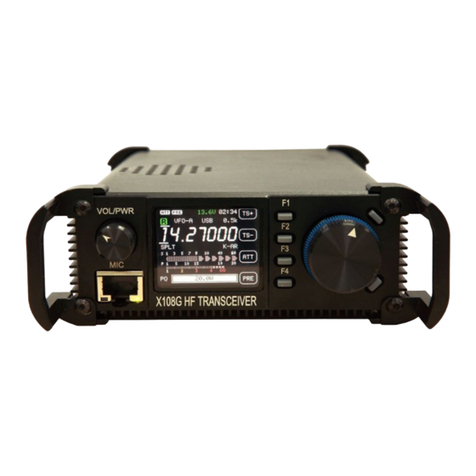
XIEGU
XIEGU X108G operating manual
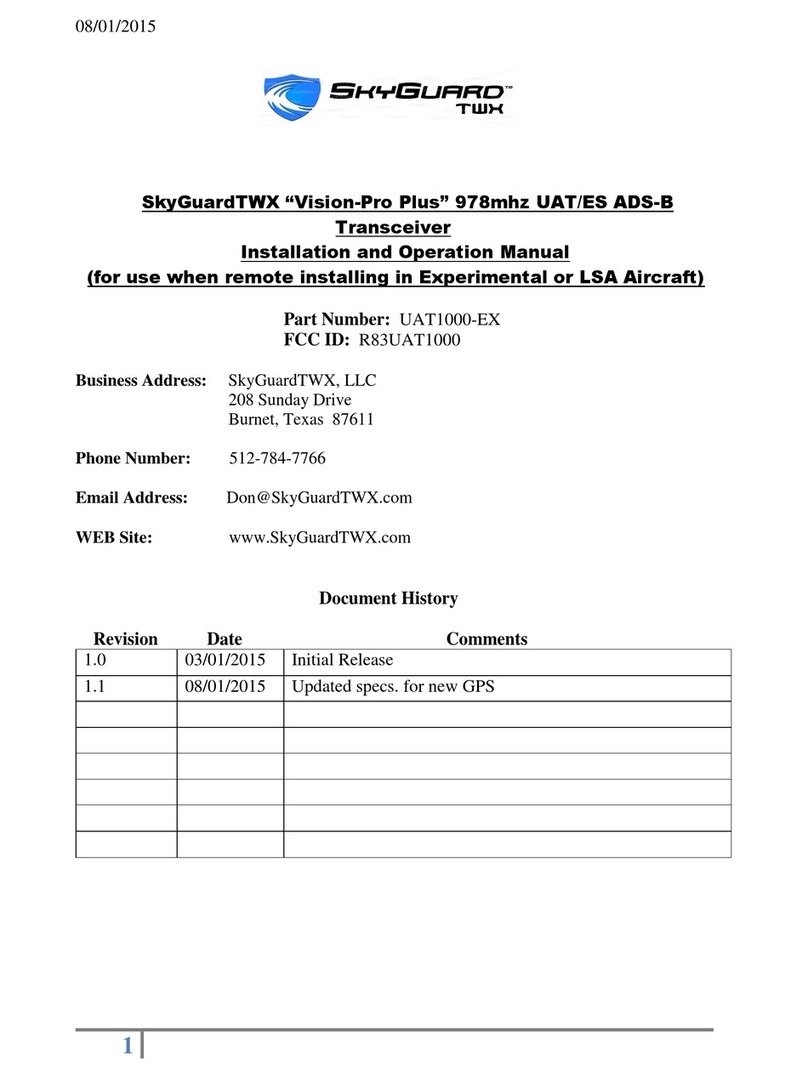
SkyGuardTWX
SkyGuardTWX Vision-Pro Plus Installation and operation manual

Uniden
Uniden ATLANTIS250 BK - ATLANTIS 250 VHF Radio Guide d'utilisation

CIRCUIT DESIGN
CIRCUIT DESIGN STD-302S Operation guide
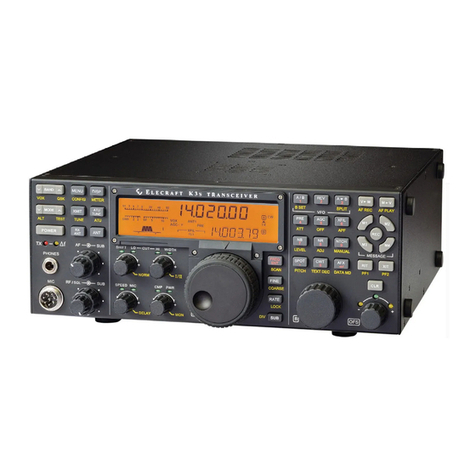
ELECRAFT
ELECRAFT K3S Programmer's reference
